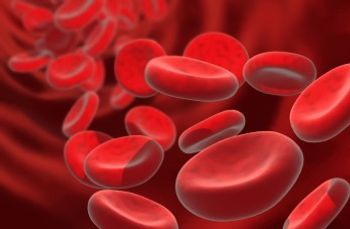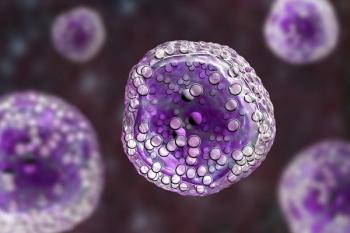
Oncology NEWS International
- Oncology NEWS International Vol 11 No 1
- Volume 11
- Issue 1
Rituximab Ups Survival in Aggressive and Indolent NHL
ORLANDO-Presentations at the 43rd Annual Meeting of the American Society of Hematology (ASH) showed increased survival for patients with aggressive and indolent non-Hodgkin’s lymphoma (NHL) who received the anti-CD20 monoclonal antibody rituximab (Rituxan) in addition to standard CHOP chemotherapy (cyclophosphamide, doxorubicin, vincristine, prednisone).
ORLANDOPresentations at the 43rd Annual Meeting of the American Society of Hematology (ASH) showed increased survival for patients with aggressive and indolent non-Hodgkin’s lymphoma (NHL) who received the anti-CD20 monoclonal antibody rituximab (Rituxan) in addition to standard CHOP chemotherapy (cyclophosphamide, doxorubicin, vincristine, prednisone).
At a median of 24 months follow-up, the Groupe d’Etude des Lymphomes de l’Adulte (GELA) phase III study showed a 23% relative increase in overall survival in patients with aggressive NHL treated with rituximab plus CHOP vs CHOP alone (abstract 3025). In a phase II indolent NHL study of rituximab plus CHOP, progression-free survival has not been reached at more than 5.4 years of follow-up (abstract 2519).
In the GELA study, 399 previously untreated patients age 60 and older with stage II to IV diffuse large B-cell lymphomas were randomized to receive either standard CHOP alone every 3 weeks for eight cycles or rituximab 375 mg/m0178 plus CHOP. Rituximab was administered on day 1 of each cycle.
Two-year event-free survival improved significantly from 37% in the CHOP alone arm to 57% in the combination arm, a relative increase of 54%. Event-free survival was defined as ongoing survival without events, including disease progression or relapse, death, or initiation of new alternative treatment.
Overall survival at 2 years was increased from 57% in the CHOP alone arm to 70% in the rituximab/CHOP arm, a relative increase of 23%. "This is the first new drug combination in more than 20 years to show an improvement in overall survival for patients with aggressive NHL," said principal investigator Bertrand Coiffier, MD, of the Hospices Civils de Lyon, France.
At 18 months, complete response rate increased from 64% in the CHOP alone arm to 77% in the combination arm, a relative increase of 20% (
P
= .007).
Case Study
In his ASH poster presentation, Dr. Myron Czuczman described the case of a 42-year-old man diagnosed with stage IIA follicular mixed CD20+ lymphoma. One residual mass was 6 cm in maximum diameter. The patient tested positive for bcl-2 in blood and marrow.
The patient achieved a complete remission at completion of therapy and remains in remission at more than 6.5 years post-therapy. He converted to and remains bcl-2 negative by serial sampling.
Apart from grade 3-4 first-infusion events, experienced by approximately 10% of patients in the rituximab/CHOP arm, toxicity was not increased by the addition of rituximab to CHOP chemotherapy, Dr. Coiffier said.
Indolent NHL
Myron Czuczman, MD, chief of the Division of Lymphoma/Myeloma, Roswell Park Cancer Institute, reported updated results of a multi-institution single-arm phase II clinical trial of rituximab plus CHOP in new and previously treated patients with advanced-stage indolent B-cell NHL.
The study, initiated in 1994, was the first clinical trial of rituximab in combination with CHOP. It showed the safety and efficacy of the combination in low-grade NHL and enabled progression to further phase II and III trials.
CHOP was administered at standard doses every 3 weeks for six cycles along with six infusions of rituximab 375 mg/m². Forty patients were enrolled; nine had received previous treatment. The median age was 48 (range, 29 to 77 years); 88% were stage III/IV at diagnosis. Of the 40 patients enrolled, 38 were treated and 35 completed all planned therapy. All treated patients responded, and the complete response rate among the 35 patients who completed treatment was 63%.
Among the 38 evaluable patients, the new analysis found that median duration of response had not been reached at 5.3 years of follow-up (range, 2.9 to 85.8 months); 21 patients have an ongoing remission. Median progression-free survival had not been reached at follow-up of more than 5.4 years (range, 4.5 to 86.3 months) and exceeds that reported with CHOP alone, he said.
Eight patients were bcl-2 positive at baseline. Post-treatment, one patient remained positive and is in complete remission at 68+ months. Three patients converted to and remain negative (see box), and all are in complete remission at 71+, 79+, and 84+ months of follow-up. Four patients converted to negative and then reverted to positive; three are in complete remission, and one progressed at 29 months of follow-up.
Conversion of bcl-2 from positive to negative in blood and bone marrow indicates clearance of minimal residual disease, Dr. Czuczman commented.
"The prolonged progression-free survival is noteworthy and provides important data for this therapy," Dr. Czuczman said. "These results suggest that Rituxan helps to sensitize cancer cells to chemotherapy, improving patient benefit without adding significant toxicity.
Articles in this issue
almost 24 years ago
ODAC Sends Mixed Message on New Gliadel Wafer Indicationalmost 24 years ago
ONCC Certification Test Results Are Announcedalmost 24 years ago
Topotecan Used in Aggressive Front-Line Therapy for SCLCalmost 24 years ago
Depsipeptide Shows Activity in T-Cell Lymphomaalmost 24 years ago
FDG-PET Useful in Newly Diagnosed and Recurrent NSCLCalmost 24 years ago
Adjuvant Anastrozole Superior to Tamoxifen in Huge ATAC Breast Cancer Trialalmost 24 years ago
ODAC Backs Adding HER-2 DNA Test to Herceptin Package Insertalmost 24 years ago
FDA and VA Plan Joint AIDS Studyalmost 24 years ago
Breast Conservation Increases With On-Site Radiation Unitalmost 24 years ago
Washington State Hikes Cigarette TaxNewsletter
Stay up to date on recent advances in the multidisciplinary approach to cancer.


















































































